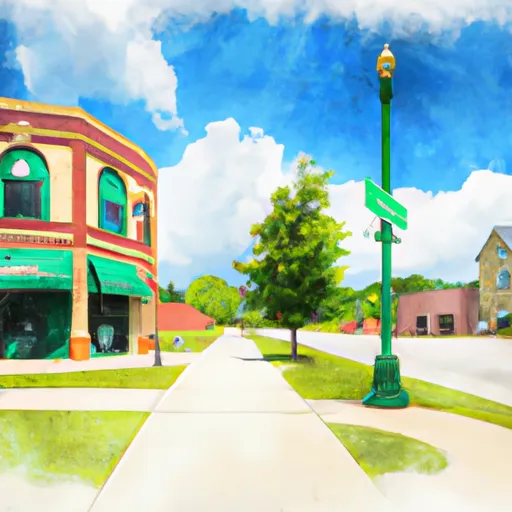-
 Snoflo Premium
Snoflo Premium
Get unlimited access to all our content
With no Ad interruptions! - Start Your Free Trial Login with existing account
Mio
Eden Index
Climate
6.2
•
Recreation
1.3
•
Community
1.5
•
Safeguard
3.3/10

Mio, Michigan is a small town located in Oscoda County, in the northern part of the Lower Peninsula. The area experiences a humid continental climate, characterized by cold winters and warm summers. Average temperatures range from 15°F (-9°C) in January to 75°F (24°C) in July, with an annual precipitation of approximately 32 inches (81 cm).
Mio is known for its beautiful natural scenery, surrounded by numerous lakes, rivers, and forests. The town lies on the banks of the Au Sable River, a well-known waterway for fishing, canoeing, and kayaking. The river is also home to various hydrology constituents, such as trout, walleye, and smallmouth bass, attracting angling enthusiasts from all around.
Outdoor recreation opportunities in Mio are abundant. The Huron National Forest, located nearby, offers hiking trails, camping sites, and opportunities for hunting and wildlife observation. The area is also famous for its extensive off-road vehicle trail system, attracting ATV and ORV enthusiasts. During winter, snowmobiling, cross-country skiing, and ice fishing are popular activities.
Overall, Mio, Michigan provides a picturesque setting for outdoor enthusiasts, offering a diverse range of activities throughout the year.
What is the Eden Index?
The Snoflo Eden Index serves as a comprehensive rating system for regions, evaluating their desirability through a holistic assessment of climate health, outdoor recreation opportunities, and natural disaster risk, acknowledging the profound impact of these factors on livability and well-being.
Climate Health Indicator (CHI): 6.2
Mio receives approximately
738mm of rain per year,
with humidity levels near 83%
and air temperatures averaging around
7°C.
Mio has a plant hardyness factor of
4, meaning
plants and agriculture in this region thrive during a short period during spring and early summer. Most
plants will die off during the colder winter months.
By considering the ideal temperature range, reliable water supplies, clean air, and stable seasonal rain or snowpacks, the Climate Health Indicator (CHI) underscores the significance of a healthy climate as the foundation for quality living.
A healthy climate is paramount for ensuring a high quality of life and livability in a region, fostering both physical well-being and environmental harmony. This can be characterized by ideal temperatures, reliable access to water supplies, clean air, and consistent seasonal rain or snowpacks.
Weather Forecast
Streamflow Conditions
Northwestern Lake Huron
Area Rivers
Northwestern Lake Huron
Snowpack Depths
Northwestern Lake Huron
Reservoir Storage Capacity
Northwestern Lake Huron
Groundwater Levels
Recreational Opportunity Index (ROI): 1.3
The Recreational Opportunity Index (ROI) recognizes the value of outdoor recreational options, such as parks, hiking trails, camping sites, and fishing spots, while acknowledging that climate plays a pivotal role in ensuring the comfort and consistency of these experiences.
Access to outdoor recreational opportunities, encompassing activities such as parks, hiking, camping, and fishing, is crucial for overall well-being, and the climate plays a pivotal role in enabling and enhancing these experiences, ensuring that individuals can engage in nature-based activities comfortably and consistently.
Camping Areas
| Campground | Campsites | Reservations | Toilets | Showers | Elevation |
|---|---|---|---|---|---|
| Onaway State Park | 100 | 700 ft | |||
| DeTour - Lake Superior State Forest | 21 | 592 ft | |||
| Aune - Osborn RV Park | 100 | 590 ft | |||
| Black Lake Trail Camp - Mackinaw State Forest | 50 | 696 ft | |||
| Munuscong River - State Forest | 50 | 596 ft | |||
| Twin Lakes - State Forest | 12 | 759 ft |
Nearby Ski Areas
Catastrophe Safeguard Index (CSI):
The Catastrophe Safeguard Index (CSI) recognizes that natural disaster risk, encompassing floods, fires, hurricanes, and tornadoes, can drastically affect safety and the overall appeal of an area.
The level of natural disaster risk in a region significantly affects safety and the overall livability, with climate change amplifying these risks by potentially increasing the frequency and intensity of events like floods, fires, hurricanes, and tornadoes, thereby posing substantial challenges to community resilience and well-being.
Community Resilience Indicator (CRI): 1.5
The Community Resilience Indicator (CRI) recognizes that education, healthcare, and socioeconomics are crucial to the well-being of a region. The CRI acknowledges the profound impact of these elements on residents' overall quality of life. By evaluating educational resources, healthcare accessibility, and economic inclusivity, the index captures the essential aspects that contribute to a thriving community, fostering resident satisfaction, equity, and social cohesion.

